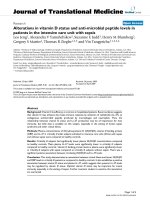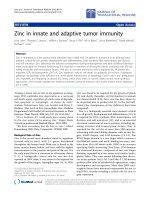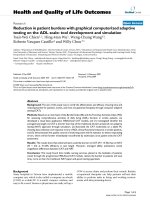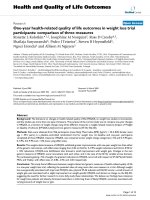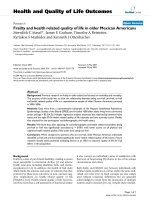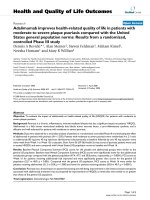báo cáo hóa học:" Increases in solar conversion efficiencies of the ZrO2 nanofiber-doped TiO2 photoelectrode for dye-sensitized solar cells" pot
Bạn đang xem bản rút gọn của tài liệu. Xem và tải ngay bản đầy đủ của tài liệu tại đây (1.6 MB, 12 trang )
This Provisional PDF corresponds to the article as it appeared upon acceptance. Fully formatted
PDF and full text (HTML) versions will be made available soon.
Increases in solar conversion efficiencies of the ZrO2 nanofiber-doped TiO2
photoelectrode for dye-sensitized solar cells
Nanoscale Research Letters 2012, 7:98 doi:10.1186/1556-276X-7-98
En Mei Jin ()
Jiao Wang ()
Ju-Young Park ()
Xing Guan Zhao ()
Wan Lin Wang ()
Hal-Bon Gu ()
ISSN 1556-276X
Article type Nano Review
Submission date 9 September 2011
Acceptance date 2 February 2012
Publication date 2 February 2012
Article URL />This peer-reviewed article was published immediately upon acceptance. It can be downloaded,
printed and distributed freely for any purposes (see copyright notice below).
Articles in Nanoscale Research Letters are listed in PubMed and archived at PubMed Central.
For information about publishing your research in Nanoscale Research Letters go to
/>For information about other SpringerOpen publications go to
Nanoscale Research Letters
© 2012 Jin et al. ; licensee Springer.
This is an open access article distributed under the terms of the Creative Commons Attribution License ( />which permits unrestricted use, distribution, and reproduction in any medium, provided the original work is properly cited.
1
Increases in solar conversion efficiencies of the ZrO
2
nanofiber-doped TiO
2
photoelectrode for dye-sensitized solar cells
Jiao Wang
1
, En Mei Jin
1
, Ju-Young Park
2
, Wan Lin Wang
1
, Xing Guan Zhao
1
, and Hal-Bon
Gu*
1
1
Department of Electrical Engineering, Chonnam National University, Gwangju, 500-757,
South Korea
2
Southwestern Research Institute of Green Energy Technology, Mokpo-si, Jeonllanam-do,
530-400, South Korea
*Corresponding author:
Email addresses:
JW:
EMJ:
J-YP:
WLW:
XGZ:
H-BG:
Abstract
In this paper, in order to improve the efficiency of dye-sensitized solar cells, we introduced
zirconia [ZrO
2
] nanofibers into a mesoporous titania [TiO
2
] photoelectrode. The
photoelectrode consists of a few weight percent of ZrO
2
nanofibers and a mesoporous TiO
2
powder. The mixed ZrO
2
nanofibers and the mesoporous TiO
2
powder possessed a larger
surface area than the corresponding mesoporous TiO
2
powder. The optimum ratio of the ZrO
2
nanofiber was 5 wt.%. The 5 wt.% ZrO
2
-mixed device could get a short-circuit photocurrent
density of 15.9 mA/cm
2
, an open-circuit photovoltage of 0.69 V, a fill factor of 0.60, and a
light-to-electricity conversion efficiency of 6.5% under irradiation of AM 1.5 (100 mW/cm
2
).
Keywords: zirconia nanofiber; titania; DSSC.
Introduction
Dye-sensitized solar cells [DSSCs] have generated a considerable research interest because of
their high-energy conversion efficiency (approximately 11%) and low production costs [1-3].
A typical DSSC device contains a light-harvesting layer on a photoelectrode and a Pt-coated
layer on a counter electrode; both electrodes are made of a transparent conducting oxide
substrate; an iodine-based electrolyte fills the space between the photoelectrode and the
counter electrode to serve as a redox mediator in a sandwich-type structure. Performance of
the DSSC depends on many factors such as the TiO
2
surface morphology, particle size,
2
thickness of the photoelectrode, nature of the dye, etc. [4-10].
A high light-to-electricity conversion efficiency results from a large surface area of the
mesoporous TiO
2
photoelectrode, on which the dyes can be sufficiently adsorbed. In this
study, we introduced zirconia [ZrO
2
] nanofibers into the mesoporous titania [TiO
2
]
photoelectrode. The ZrO
2
nanofibers are prepared by electrospinning. The TiO
2
film
composite with ZrO
2
nanofibers creates a larger surface area than the single TiO
2
film, in
which case the amount of dye loading was increased and short-circuit photocurrent density
and solar conversion efficiency are also increased.
Experimental details
The ZrO
2
nanofiber additives were prepared by electrospinning method. At first, mixed
together, 6 ml zirconium acetate, 12 ml acetic acid, 12 ml ethanol, and 50 g poly(methyl
methacrylate) were stirred for 24 h; then, the compounds were sintered at 700°C for 4 h. A
detailed process is displayed in Figure 1.
The TiO
2
paste was prepared by mixing TiO
2
with Degussa P-25, polyethylene glycol, acetyl
acetone, distilled water, triton X-100, HNO
3
, and ZrO
2
nanofibers. The concentrations of
ZrO
2
nanofibers were 0, 3, 5, and 7 wt.%. The mixed solutions were ball milled at 100 rpm
for 10 h. The photoelectrode was fabricated using a clean fluorine-doped tin dioxide [FTO]
(approximately 8 Ω/cm
2
, Pilkington conductive glass, Seoul, South Korea) by squeeze
printing. The coated photoelectrode was heat treated at 450°C for 30 min with a heating rate
of 5°C/min. The obtained photoelectrode was immersed into the ethanol solution containing
[cis-diisothiocyanato-bis(2,2′-bipyridyl-4,4′-dicarboxylato)ruthenium(II)
bis(tetrabutylammonium)] (N719 dye, Solaronix, Aubonne, Switzerland) for 24 h. The active
area of the photoelectrode was 0.5 × 0.5 cm
2
. On the other hand, the counter electrode was
prepared similar to the photoelectrode preparation. Pt-Sol (Pt catalyst/SP, Solaronix) was
coated onto the FTO glass by the squeeze printing method. The coated paste was heat treated
at 450°C for 30 min with a heating rate of 5°C/min.
The electrolyte solution consisted of 0.3 M 1,2-dimethyl-3-propylimidazolium iodide, 0.5 M
Li(I), 0.05 M I
2
, and 0.5 M 4-t-butylpyridine in 3-methoxypropionitrile between the two
electrodes. The dye-coated photoelectrode and the Pt-coated counter electrode were
sandwiched using a 60-µm-thick hot-melt sealing foil (SX 1170-60, Solaronix).
The field-emission scanning electron microscope [FE-SEM] (S-4700, Hitachi, Seoul, South
Korea) and BET were used to examine the morphology and the pore distribution volume of
the TiO
2
film. In order to investigate the physical and optical characteristics of the dye-
adsorbed TiO
2
films, the UV-visible [UV-Vis] spectrum measurement was performed. The
photovoltaic properties were investigated by measuring the photocurrent-voltage
characteristics under illumination with air mass [AM] 1.5 (100 mW/cm
2
) simulated sunlight.
3
Results and discussion
Figure 2 shows the FE-SEM images of the TiO
2
film's surface and the 5 wt.% ZrO
2
nanofiber-
added TiO
2
film's surface. In the ZrO
2
nanofiber-added TiO
2
film in Figure 2b, the ZrO
2
nanofiber was shown at the surface of the TiO
2
film, or the TiO
2
film was studded with the
ZrO
2
nanofiber. The TiO
2
film's surface area was increased, and the dye adsorption contents
became larger by the addition of the ZrO
2
nanofiber. So, we can forecast that the TiO
2
electrode is able to obtain high conversion efficiency.
Figure 3 shows the pore distributions calculated from adsorption data using the
Barrett−Joyner−Halenda [BJH] method. As shown in Figure 3, a broad peak was found at
around 25 nm, and an added 5 wt.% ZrO
2
nanofiber at around 30 nm was observed.
Compared to the pure TiO
2
film, the 5 wt.% ZrO
2
nanofiber-added TiO
2
films show a
significant change in the pore size distribution. A large pore volume in BJH was observed on
the TiO
2
film with 5 wt.% ZrO
2
nanofibers, which is in agreement with the results of the FE-
SEM image.
Figure 4 shows the UV-Vis absorption spectra of the dye-adsorbed TiO
2
film and the 3, 5, and
7 wt.% ZrO
2
nanofiber-doped TiO
2
films. From the results, the absorption spectra increased at
around 538 nm with added ZrO
2
nanofibers doped in the TiO
2
film and also enhanced the
amount of dye loading. So, the 5 wt.% ZrO
2
nanofiber-doped TiO
2
film had the best dye
loading, and also, its solar conversion efficiency was the best among the samples.
In order to determine the factors that influence the stability of the DSSCs, electrochemical
impedance spectroscopy [EIS] was performed. Figure 5 shows that the Nyquist plot of EIS of
the DSSCs exhibits semicircles, which are assigned to the electrochemical reaction at the Pt
counter electrode, the charge transfer at the TiO
2
/dye/electrolyte interface, and the Warburg
diffusion process of I
−
/I
3
−
[9, 10]. As shown in Figure 5, the second semicircle is the
resistance (R
2
) related to the electron transport in the TiO
2
/dye/electrolyte interface which is
reduced. It can be seen that the TiO
2
film and the 3, 5, and 7 wt.% ZrO
2
nanofiber-doped TiO
2
films are 13.2, 10.3, 9.6, and 11.9 Ω, respectively.
Figure 6 shows photocurrent-voltage characteristics of the DSSCs with the ZrO
2
nanofiber-
doped TiO
2
film. The open-circuit photovoltage was almost the same, and the short-circuit
photocurrent density increased with the added amount of ZrO
2
nanofibers and had reached the
maximum at 5 wt.% of ZrO
2
nanofiber (15.9 mA/cm
2
). The open-circuit photovoltage [V
oc
],
the short-circuit photocurrent density [J
sc
], the fill factor [FF], and the light-to-electricity
conversion efficiency [η] at 5 wt.% added ZrO
2
nanofiber were 0.69 V, 15.9 mA/cm
2
, 0.60,
and 6.5%, respectively, as shown in Table 1. From the results, we can realize that the insertion
of ZrO
2
nanofibers creates a larger surface area and reduces the resistance of the
photoelectrode, especially for the optimal amount of ZrO
2
contents (7 wt.%) of the
photoelectrode in DSSCs.
4
Conclusions
In summary, a ZrO
2
nanofiber-doped TiO
2
film was used as a photoelectrode in DSSCs. The
ZrO
2
nanofiber-doped TiO
2
films had a larger surface area than the pure TiO
2
film, in which
case the amount of dye loading was increased, and J
sc
and η were also increased. The
optimum ratio of the ZrO
2
nanofiber was 5 wt.%. The DSSC with the 5 wt.% ZrO
2
nanofiber
photoelectrode provided the highest η of 6.5%, J
sc
of 15.9 mA/cm
2
, V
oc
of 0.69 V, and FF of
0.60 under AM 1.5 (100 mW/cm
2
) simulated sunlight illumination. Therefore, ZrO
2
fibers are
a promising additive for the realization of high-efficiency DSSCs.
Competing interests
The authors declare that they have no competing interests.
Authors' contributions
JW fabricated the DSSCs and UV-Vis analysis. EMJ was the paper chaser and performed the
analysis of photocurrent-voltage characteristics and impedance. WLW performed the BET
analysis. J-YP prepared the ZrO
2
nanofibers. XGZ performed the FE-SEM analysis. H-BG
was thesis director. All authors read and approved the final manuscript.
References
1. O’Regan B, Grätzel M: A low-cost, high-efficiency solar cell based on dye-sensitized
colloidal titanium dioxide films. Nature 1991, 335:737-740.
2. Nazeeruddin MK, Kay A, Rodicio I, Humphry R, Muller E, Liska P, Vlachopoulos N,
Grätzel M: Conversion of light to electricity by cis-X2bis(2,2′-bipyridyl-4,4′-
dicarboxylate (ruthenium(II) charge transfer sensitizers)X=Cl-, Br1, I-, Cn-, and
SCN-) on nanocrystalline titanium dioxide electrodes. J Am Chem Soc 1993, 115:6382-
6390.
3. Hore S, Vetter C, Kern R, Smit H, Hinsch A: Influence of scattering layers on efficiency
of dye-sensitized solar cells. Sol Energy Mater 2006, 90:1176-1188.
4. Park K, Gu H, Jin EM, Dhayal M: Using hybrid silica-conjugated TiO
2
nanostructure to
enhance the efficiency of dye-sensitized solar cells. Electrochimica Acta 2010, 55:5499-
5505.
5. Seigo Ito, Takayuki Kitamura, Yuji Wada, Shozo Yanagida: Facile fabrication of
mesoporous TiO
2
electrodes for dye solar cells: chemical modification and repetitive
coating. Solar Energy Mater Solar Cells 2003, 76:3-13.
6. Jin EM, Park K, Yun J, Hong CK, Hwang M, Park B, Kim K, Gu H: Photovoltaic
properties of TiO
2
photoelectrode prepared by using liquid PEG-EEM binder.
Surface Rev Lett (SRL) 2010, 17:15-20.
7. Park KH, Jin EM, Gu HB, Shim SE, Hong CK: Effects of HNO
3
treatment of TiO
2
nanoparticles on the photovoltaic properties of dye-sensitized solar cells. Mater Lett
2009, 63:2208-2211.
8. Chuen-Shii Chou, Ru-Yuan Yang, Cheng-Kuo Yeh, You-Jen Lin: Preparation of
TiO
2
/nano-metal composite particles and their applications in dye-sensitized solar
cells. Powder Technol 2009, 194:95-105.
9. Fabregat-Santiago F, Bisquert J, Garcia-Belmonte G, Boschloo G, Hagfeldt A: Influence of
5
electrolyte in transport and recombination in dye-sensitized solar cells studied by
impedance spectroscopy. Solar Ener Mat Solar Cells 2005, 87:117-131.
10. Naoki Koide, Ashraful Islam, Uasou Chiba, Liyuan HAn: J Photochem Photobiol A:
Improvement of efficiency of dye-sensitized solar cells based on analysis of
equivalent circuit. Chem 2006, 182:296-305.
Figure 1. Preparation of the ZrO
2
nanofiber.
Figure 2. FE-SEM images of (a) TiO
2
film and (b) 5 wt.% ZrO
2
nanofiber-doped TiO
2
film.
Figure 3. BJH curve of TiO
2
film (triangle) and 5 wt.% ZrO
2
nanofiber-doped TiO2 film
(square).
Figure 4. UV-Vis spectrum of TiO
2
film and ZrO
2
nanofiber-doped TiO
2
film after 24-h
dye absorption.
Figure 5. Nyquist plots of the DSSCs using TiO
2
film and ZrO
2
nanofiber-doped TiO
2
film. Black circle, 0 wt.%; red diamond, 3 wt.%; cross mark, 5 wt.%; green triangle, 7 wt.%.
Figure 6. Photocurrent-voltage curve of the TiO
2
film and the TiO
2
films with ZrO
2
nanofibers.
Table 1. Photocurrent-voltage characteristics of DSSCs using TiO
2
with different
amounts of ZrO
2
nanofibers
Sample V
oc
(V) J
sc
(mA/cm
2
)
FF η (%)
Pure TiO
2
0.68 11.5 0.62 4.9
3 wt.% ZrO
2
nanofiber-doped TiO
2
0.69 14.9 0.60 6.2
5 wt.% ZrO
2
nanofiber-doped TiO
2
0.69 15.9 0.60 6.5
7 wt.% ZrO
2
nanofiber-doped TiO
2
0.69 14.7 0.59 6.0
V
oc
, open-circuit photovoltage; J
sc
, short-circuit photocurrent density; FF, fill factor; η, light-
to-electricity conversion efficiency; TiO
2
, titania; ZrO
2
, zirconia.
Figure 1
Figure 4
Figure 5
Figure 6


